Analysis
BigBite Momentum resolution (for NIM paper)
Am am reanalyzing elastic data (1GeV, 2GeV, 3GeV) to get new plots
of the BigBite resolution and offsets.
My old plot:
01.) 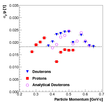 02.)
02.) 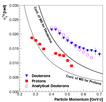 03.)
03.) 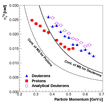 04.)
04.)  05.)
05.) 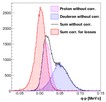
My new plot:
06.)  07.)
07.)  08.)
08.)  09.)
09.)  10.)
10.) 
11.)  12.)
12.)  13.)
13.) 
Offsets :
Need to correct small offsets for TgTh and TgPh. To correct TgTh
offset I will introduce a -0.0015rad term to the HRSL optics matrix.
To correct for the TgPh offset I will increase the zero-order Phi term
in the BigBite optics matrix for 0.002734.
14.) 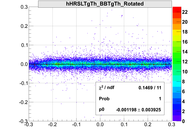 15.)
15.) 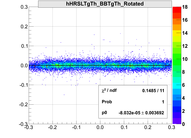
16.) 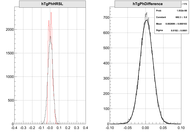 17.)
17.) 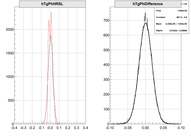
18.)  19.)
19.) 
Scaler problem
On Wednesday we were discussing strange behavior of the
ratio of the gated BCM scalers (I call this ratio charge ratio).
This ratio should be one and basically tells us, what is the amount
of the accumulated positive (spin) charge relative to the collected
negative (spin) charge. The result of my analysis was shown on the
following figure. Please follow link:
http://descartes.ijs.si/~miham/e05102/MeetingNo76/Meeting1.png
On our meeting, we could not understand, where the observed oscillations
(or asymmetry) came from. Therefore I decided to spend some
time on this topic and try to understand what causes this kind of behavior.
Now I believe I understand what is happening.
20.) 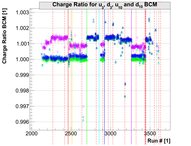
First, please see figure above. This is the same picture as before, but
without HWP correction. Blue squares correspond to BCM.u3 results. I have
also added some lines, that show run numbers, where we inserted HWP
(dashed lines) and where the target orientation was changed (full lines).
For the plot of target spin orientation please follow link:
http://descartes.ijs.si/~miham/e05102/TargetFieldPolarization/TargetFieldOrientation.png
I realized that problems start at run #2700 where we changed the scalers for
the first time. Please see the link:
http://hallaweb.jlab.org/halog/log/html/0905_archive/090524191328.html
Until that run we were using "negative" pair of gated scalers
(Target, Helicity) = (-+) and (--), regardless of the target orientation. After this run we
started to use "positive" pair of scalers (++), (+-). To confirm this assumption I made
some additional analysis using HALOG end-of-run data and I realized, that problems
happen only when the second pair of scalers (++), (+-) was used. For runs where
pair (-+),(--) was used, ratio returned again to 1. Please see figures below,
which show the charge accumulated by each gated BCM.U3 scaler and the final ratio between
"positive" and "negative" accumulated charge.
21.) 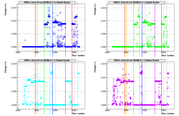 22.)
22.) 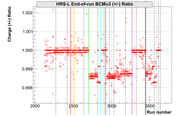
My explanation for this is, that we must have had a problem with one of the two gated
scaler modules from the pair ( (++) or (+-)). To verify this, I made the same analysis
using HRS-R BCM data. Result of that analysis are shown on figures below:
23.) 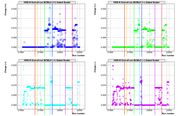 24.)
24.) 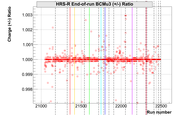
From these plots you can see, that HRS-R scalers did not detect any
jump in the charge ratio, which suggests that my strange results from Wednesday are most
likely wrong due to the bad scaler module. I also remember, that we had multiple
problems/encounters with double pulsing in the HRS-L scalers.
Now I would like to ask you, what do you think about this? Would you agree with my conclusions?
Do you think that I should redo my BCM analysis using HRS-R data or is it enough to use good
HRS-L data together with the HRS-R HALOG results?
Last modified: 11/23/11
 02.)
02.)  03.)
03.)  04.)
04.)  05.)
05.) 
 07.)
07.)  08.)
08.)  09.)
09.)  10.)
10.) 
 12.)
12.)  13.)
13.) 
 15.)
15.) 
 17.)
17.) 
 19.)
19.) 

 22.)
22.) 
 24.)
24.) 